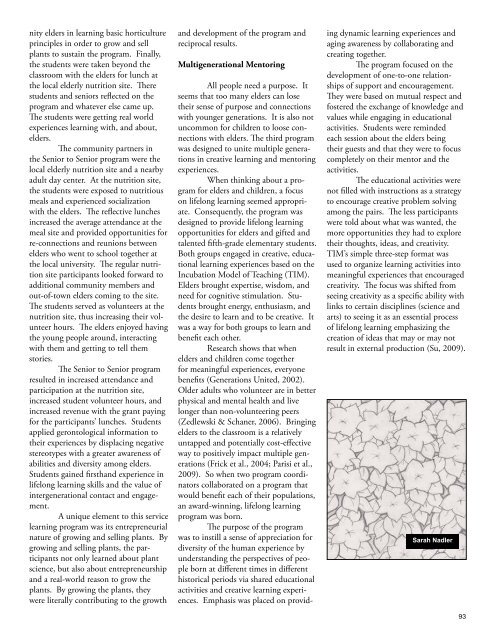Torrance Journal for Applied Creativity
TorranceJournal_V1
TorranceJournal_V1
You also want an ePaper? Increase the reach of your titles
YUMPU automatically turns print PDFs into web optimized ePapers that Google loves.
nity elders in learning basic horticulture<br />
principles in order to grow and sell<br />
plants to sustain the program. Finally,<br />
the students were taken beyond the<br />
classroom with the elders <strong>for</strong> lunch at<br />
the local elderly nutrition site. There<br />
students and seniors reflected on the<br />
program and whatever else came up.<br />
The students were getting real world<br />
experiences learning with, and about,<br />
elders.<br />
The community partners in<br />
the Senior to Senior program were the<br />
local elderly nutrition site and a nearby<br />
adult day center. At the nutrition site,<br />
the students were exposed to nutritious<br />
meals and experienced socialization<br />
with the elders. The reflective lunches<br />
increased the average attendance at the<br />
meal site and provided opportunities <strong>for</strong><br />
re-connections and reunions between<br />
elders who went to school together at<br />
the local university. The regular nutrition<br />
site participants looked <strong>for</strong>ward to<br />
additional community members and<br />
out-of-town elders coming to the site.<br />
The students served as volunteers at the<br />
nutrition site, thus increasing their volunteer<br />
hours. The elders enjoyed having<br />
the young people around, interacting<br />
with them and getting to tell them<br />
stories.<br />
The Senior to Senior program<br />
resulted in increased attendance and<br />
participation at the nutrition site,<br />
increased student volunteer hours, and<br />
increased revenue with the grant paying<br />
<strong>for</strong> the participants’ lunches. Students<br />
applied gerontological in<strong>for</strong>mation to<br />
their experiences by displacing negative<br />
stereotypes with a greater awareness of<br />
abilities and diversity among elders.<br />
Students gained firsthand experience in<br />
lifelong learning skills and the value of<br />
intergenerational contact and engagement.<br />
A unique element to this service<br />
learning program was its entrepreneurial<br />
nature of growing and selling plants. By<br />
growing and selling plants, the participants<br />
not only learned about plant<br />
science, but also about entrepreneurship<br />
and a real-world reason to grow the<br />
plants. By growing the plants, they<br />
were literally contributing to the growth<br />
and development of the program and<br />
reciprocal results.<br />
Multigenerational Mentoring<br />
All people need a purpose. It<br />
seems that too many elders can lose<br />
their sense of purpose and connections<br />
with younger generations. It is also not<br />
uncommon <strong>for</strong> children to loose connections<br />
with elders. The third program<br />
was designed to unite multiple generations<br />
in creative learning and mentoring<br />
experiences.<br />
When thinking about a program<br />
<strong>for</strong> elders and children, a focus<br />
on lifelong learning seemed appropriate.<br />
Consequently, the program was<br />
designed to provide lifelong learning<br />
opportunities <strong>for</strong> elders and gifted and<br />
talented fifth-grade elementary students.<br />
Both groups engaged in creative, educational<br />
learning experiences based on the<br />
Incubation Model of Teaching (TIM).<br />
Elders brought expertise, wisdom, and<br />
need <strong>for</strong> cognitive stimulation. Students<br />
brought energy, enthusiasm, and<br />
the desire to learn and to be creative. It<br />
was a way <strong>for</strong> both groups to learn and<br />
benefit each other.<br />
Research shows that when<br />
elders and children come together<br />
<strong>for</strong> meaningful experiences, everyone<br />
benefits (Generations United, 2002).<br />
Older adults who volunteer are in better<br />
physical and mental health and live<br />
longer than non-volunteering peers<br />
(Zedlewski & Schaner, 2006). Bringing<br />
elders to the classroom is a relatively<br />
untapped and potentially cost-effective<br />
way to positively impact multiple generations<br />
(Frick et al., 2004; Parisi et al.,<br />
2009). So when two program coordinators<br />
collaborated on a program that<br />
would benefit each of their populations,<br />
an award-winning, lifelong learning<br />
program was born.<br />
The purpose of the program<br />
was to instill a sense of appreciation <strong>for</strong><br />
diversity of the human experience by<br />
understanding the perspectives of people<br />
born at different times in different<br />
historical periods via shared educational<br />
activities and creative learning experiences.<br />
Emphasis was placed on providing<br />
dynamic learning experiences and<br />
aging awareness by collaborating and<br />
creating together.<br />
The program focused on the<br />
development of one-to-one relationships<br />
of support and encouragement.<br />
They were based on mutual respect and<br />
fostered the exchange of knowledge and<br />
values while engaging in educational<br />
activities. Students were reminded<br />
each session about the elders being<br />
their guests and that they were to focus<br />
completely on their mentor and the<br />
activities.<br />
The educational activities were<br />
not filled with instructions as a strategy<br />
to encourage creative problem solving<br />
among the pairs. The less participants<br />
were told about what was wanted, the<br />
more opportunities they had to explore<br />
their thoughts, ideas, and creativity.<br />
TIM’s simple three-step <strong>for</strong>mat was<br />
used to organize learning activities into<br />
meaningful experiences that encouraged<br />
creativity. The focus was shifted from<br />
seeing creativity as a specific ability with<br />
links to certain disciplines (science and<br />
arts) to seeing it as an essential process<br />
of lifelong learning emphasizing the<br />
creation of ideas that may or may not<br />
result in external production (Su, 2009).<br />
Sarah Nadler<br />
93


